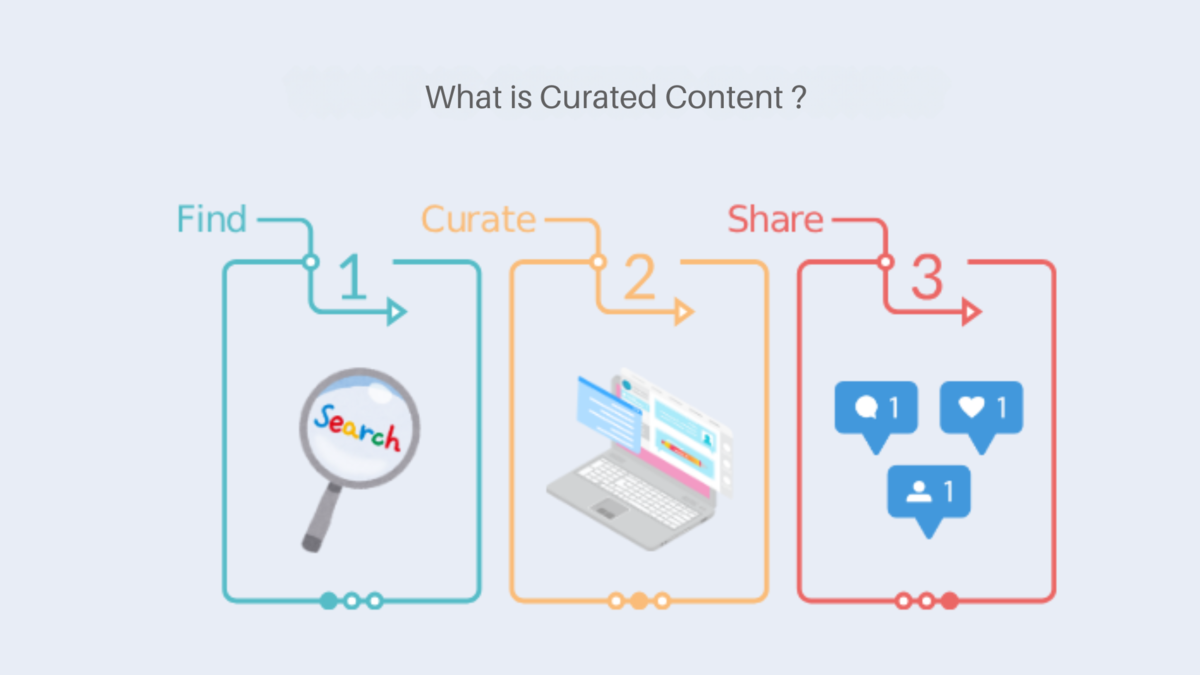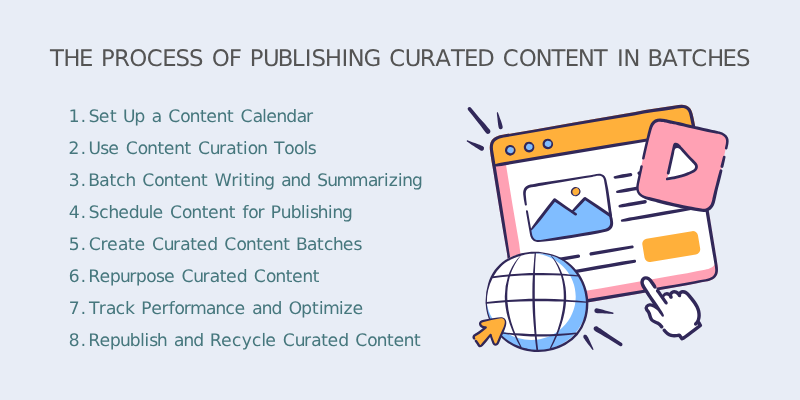With a constant stream of new content being published, how do you ensure you're focusing on what truly matters?
This is where What is Curated Content becomes valuable.
By carefully selecting high-quality, relevant resources, content curation saves you time and ensures you’re engaging with only the best insights from trusted sources.
This curated list features a collection of the most informative and useful resources on [Topic/Theme].
Whether you're a business leader, marketer, or someone passionate about the subject, this content offers the latest industry trends, expert opinions, and actionable strategies that you can start applying right away.
Instead of sorting through endless content, you can rely on this selection to bring you the best of what’s available, making it easier for you to stay on top of the trends that matter most.
What is Curated Content?
Curated content meaning involves finding, selecting, and sharing relevant, high-quality external materials with your audience, tailored to your brand or interests, instead of producing everything from scratch. By choosing and presenting resources like articles, blog posts, or social media content, curators enhance value with their own insights or context, establishing themselves as trusted experts, fostering audience engagement, and offering a varied range of information beyond mere self-promotion.
Generally, the content curation process follows three essential steps:

1. Find
Finding high-quality, authentic, and engaging content can be challenging in the vast ocean of online resources.
The best content is often buried deep and may not appear on the first page of Google search results.
To uncover valuable material on a specific topic, consider subscribing to top industry newsletters, searching for popular posts on social media using hashtags, or exploring content aggregators and well-known portals.
2. Curate
It’s crucial to read the entire content, not just the headline or introductory paragraph. Before sharing someone else’s work, ensure that it’s worth promoting to your audience.
You don’t need to share every piece you come across; instead, curate content strategically. Bookmark your favorites and plan a content schedule to stay organized and efficient.
3. Share
The timing, platform, and method you choose to share content are key to your success. Think creatively about where and how to distribute your curated content.
Consider exploring social media channels or other marketing avenues that may not be immediately obvious but could open up new opportunities and expand your reach.
Why Content Curation Matters?
Curated social content provides businesses with an opportunity to highlight valuable resources without spending time creating everything from scratch. It helps businesses establish thought leadership, improve audience engagement, and stay relevant in their industry.
-
Saves Time and Resources: Curating high-quality content is faster than creating original pieces, allowing businesses to maintain an active online presence.
-
Builds Authority: Sharing well-selected content with your insights positions you as a knowledgeable source in your field.
-
Engages Audiences: Curated content provides diverse perspectives, keeping your audience interested and informed.
- Supports SEO: Sharing curated content with proper attribution can drive traffic to your site and improve search engine rankings when paired with original content.
Content Curation vs Original Content Creation
To clarify the difference between curated and original content, here’s a comparison based on 2026 industry data:
|
Aspect |
Curated Content |
Original Content |
|
Time to Produce |
1-2 hours (finding, contextualizing) |
4-10 hours (research, writing, design) |
|
Cost |
Low (free or minimal subscription costs) |
High (requires staff, tools, or freelancers) |
|
Frequency |
Daily or weekly |
Weekly or monthly |
|
Audience Engagement |
High with added commentary |
High with unique brand voice |
This table shows that curated content allows for more frequent posting with lower costs, while original content requires more investment but offers a unique brand perspective. A balanced strategy combining both can maximize engagement and efficiency.
How To Find The Right Content For Your Audience?
Curating the right content for your target audience requires effort and time, but the payoff is worth it.
Here are a few strategies to help you effectively find and curate content
- Audit Existing Content: Review your current content to see what resonates with your audience. Understand which pieces are performing well and why.
- Create Detailed Audience Personas: Develop clear personas to guide your content curation. This will help ensure the content you share is relevant and tailored to your audience’s needs.
- Research Consumer Questions: Look for the questions your audience is asking. This could be through social media, forums, or direct customer feedback. Answering these questions will make your content more valuable.
- Gather Content from Trusted Sources: Collect content from reliable and respected sources. Sharing trusted material builds credibility and trust with your audience.
- Repurpose Top-Performing Content: Repurpose your best content across different channels to maximize its reach and impact.
- Monitor Competitors: Keep an eye on your competitors to understand what content they are sharing. This can provide ideas and inspiration for your own curation.
- Experiment with Content Formats: Don’t stick to just one type of content. Test out blogs, videos, infographics, and social media posts to see what works best for your audience.
Explore Our Content Marketing Services!
Process of Publishing Curated Content in Batches
Managing and publishing curated content in batches can save time, ensure consistency, and allow for better organization.
Here’s a step-by-step approach to manage and publish curated content in batches efficiently

1. Set Up a Content Calendar
Organizing curated content in batches begins with scheduling and mapping out a plan through a content calendar.
This helps visualize when and where content will be published. Tools like Trello, Google Sheets, or Asana are useful for setting up the calendar.
Each batch should be labeled with specific topics, and deadlines should be assigned for content curation, writing, and publishing. This ensures a structured workflow and that the content is consistently produced and shared.
2. Use Content Curation Tools
Content curation tools help streamline the process of finding, organizing, and categorizing content. These tools can automatically fetch content based on predefined keywords, saving valuable time.
Tools such as Feedly, Pocket, and Scoop.it allow you to follow blogs, save articles for later reading, or create curated feeds based on specific topics.
Automating content curation streams using these tools reduces the need to search manually and ensures a steady flow of relevant resources for your audience.
3. Batch Content Writing and Summarizing
When curating content, writing summaries or commentaries for multiple pieces in one go can save time and reduce task-switching.
After selecting 5-10 articles or resources, summarize each one, focusing on key points, actionable takeaways, and relevance.
Writing the content in batches helps maintain consistency and ensures efficiency, especially when using templates with a structured format. This approach allows for quick content creation, saving time for other tasks.
4. Schedule Content for Publishing
Scheduling the content for publishing ensures consistent delivery, even during busy periods. Tools like Buffer or Hootsuite can schedule social media posts in advance, while platforms such as WordPress or Medium allow you to schedule blog posts.
By doing so, you can automate content delivery, ensuring it goes live at peak times for maximum engagement and visibility.
5. Create Curated Content Batches
Creating curated content batches involves grouping similar content under a theme and managing them in bulk.
For example, curating multiple articles on a specific topic, like "Digital Marketing Trends," and releasing them sequentially, helps maintain focus and consistency.
Using editorial tools like Google Docs or project management tools helps prepare and edit the content in batches, streamlining the process.
6. Repurpose Curated Content
Repurposing curated content extends its value by delivering it in multiple formats. For example, converting a summary into a social media post, infographics, or creating a blog post or eBook with a collection of curated articles helps reach a broader audience across different platforms.
Repurposing ensures the content remains valuable and accessible to various segments of your audience.
7. Track Performance and Optimize
Tracking the performance of curated content regularly allows you to evaluate what works and what doesn’t. Tools like Google Analytics and social media insights provide useful metrics on engagement, user behavior, and conversions.
8. Republish and Recycle Curated Content
Over time, curated content may lose its relevance or become outdated. Republishing and recycling content by updating summaries, adding new insights, or resharing it on social media ensures that high-performing content remains visible.
Tools like SocialBee or Buffer can automate this process, making it easier to refresh older content and keep it relevant for new audiences.
Best Practices for Content Curation
There is no universal formula for how often or what content to curate, but research highlights that top content marketers typically produce
- 65% original content
- 25% curated content
- 10% syndicated content
To determine the right mix for your business, tools like Sprout Social can help track how often your audience engages with curated versus original content. Some of the best practices include experimenting with diverse content sources and formats.
Here are some additional best practices for enhancing your content curation strategy
- Use a Variety of Content Types: Mix things up by sharing different types of content, such as blogs, infographics, eBooks, videos, articles, and images. This keeps your feed dynamic and appealing.
- Explore Diverse Sources: Don’t limit yourself to one website or platform. Broaden your sources to gather fresh, diverse perspectives and ensure you’re sharing the best information available.
- Add Your Voice: Share your perspective on the curated content. Adding commentary or insights personalizes the content and helps your personality shine through.
- Leverage the Right Tools: Tools like Sprout Social help streamline the curation process and organize your content, making it easier for team members to share the right posts at the right time.
- Track Performance: Regularly assess the performance of curated content by tracking engagement metrics. This ensures you’re sharing content that resonates with your audience.
- Empower Your Team: Encourage employee advocacy by providing them with curated content that they can share. Tools designed for content advocacy can help amplify your message across a wider network
Avoiding Common Curation Pitfalls
One common mistake is over-curating without adding unique commentary, which can make your brand seem unoriginal. Another is failing to verify source credibility, which can harm your reputation.
For example, a 2026 case study showed that brands sharing unverified content saw a 15% drop in audience trust. Always vet sources and add your perspective to maintain authenticity, addressing a gap in the original content by highlighting potential risks
Frequently Asked Questions
What is an example of curated content?
Curated content is a collection of articles, videos, or images selected from various sources on a specific topic, like sharing expert health tips from multiple trusted websites.
How to create curated content?
Find relevant content from reputable sources, select the best, add your insights or commentary, and share it with your audience.
What are the 5 C's of curation?
The 5 C's are Content Discovery, Content Curation, Content Creation, Content Sharing, and Content Evaluation.
What can I say instead of curated?
You can use terms like collected, assembled, compiled, selected, or handpicked.
Conclusion
It’s a powerful strategy for businesses to share high-quality, relevant content without the constant need for original creation. By carefully selecting and contextualizing third-party content, you can maintain a consistent online presence, build audience trust, and drive engagement cost-effectively.
What is Curated Content? lies in its ability to save time while keeping your audience informed and engaged. By following best practices, using the right tools, and balancing curated and original content, you can create a robust content strategy that resonates with your audience in 2026.
Start curating content today with Centric to stay active, authoritative, and connected with your audience. Use tools like Feedly and Hootsuite, add your unique perspective, and watch your engagement grow.









